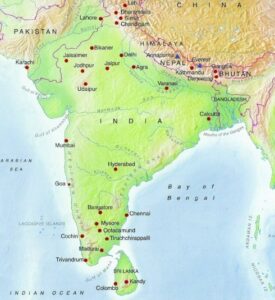Roadmap for Answer Writing Introduction Begin with a brief introduction to the Himalayas, stating their significance in terms of geography, culture, and ecology. Mention their role as one of the youngest and most prominent mountain ranges in the world. Origin Tectonic Collision: Explain how the Himalayas ...
The Indian subcontinent is considered a subcontinent due to its distinct geographic and geological features. Geologically -it is part of the Indian Plate, which separated from Gondwana and collided with the Eurasian landmass around 55 million years ago. Geographically- it is a large, peninsular regiRead more
The Indian subcontinent is considered a subcontinent due to its distinct geographic and geological features.
Geologically –it is part of the Indian Plate, which separated from Gondwana and collided with the Eurasian landmass around 55 million years ago.
Geographically- it is a large, peninsular region in South Asia, delineated by the Himalayas to the north, the Hindu Kush to the west, and the Arakanese to the east. It is bounded by the Indian Ocean to the south, the Arabian Sea to the southwest, and the Bay of Bengal to the southeast.
This region’s relative isolation from the rest of Eurasia, coupled with its unique climatic and cultural diversity, reinforces its classification as a subcontinent.
The varied landscapes and rich socio-cultural tapestry within the subcontinent reflect its historical significance and distinct identity.
Therefore, The main reason India is considered a subcontinent is its distinct geographical separation from the rest of Asia, primarily due to the imposing Himalayan mountain range to the north, which creates a natural barrier. This physical separation, combined with the subcontinent’s unique climate, ecosystems, and cultural identity, contributes to its classification as a subcontinent.


Model Answer Introduction The Himalayas, an iconic mountain range spanning multiple countries in South Asia, are central to the region’s geography, climate, and culture. Their origin, geological structure, and topographical features highlight the dynamic processes shaping this majestic landscape. OrRead more
Model Answer
Introduction
The Himalayas, an iconic mountain range spanning multiple countries in South Asia, are central to the region’s geography, climate, and culture. Their origin, geological structure, and topographical features highlight the dynamic processes shaping this majestic landscape.
Origin
Geological Structure
Topographical Features
Home to several peaks over 8,000 meters, contributing to their allure for mountaineers.
Rivers like the Ganges and Brahmaputra carve deep valleys, such as the Indus and Kathmandu Valleys.
Includes the Tibetan Plateau, known as the “Roof of the World,” and the Ladakh Plateau.
Glaciers such as Gangotri and Siachen shape the terrain and provide vital freshwater resources.
Conclusion
The Himalayas are a testament to Earth’s dynamic geology, influencing South Asia’s ecosystems, water supply, and cultures. They remain a symbol of nature’s grandeur and resilience.
See less